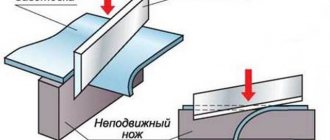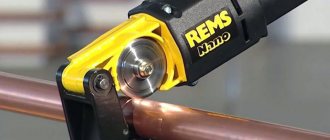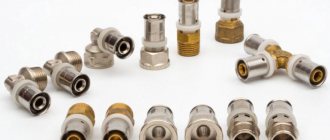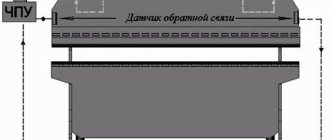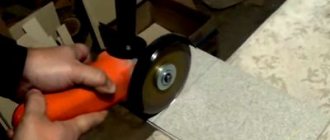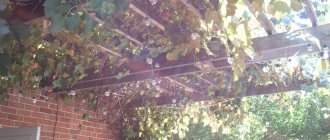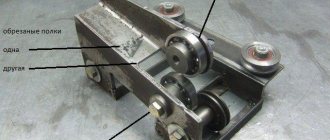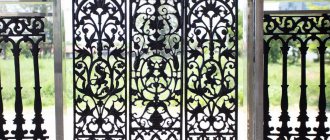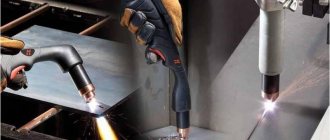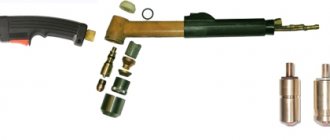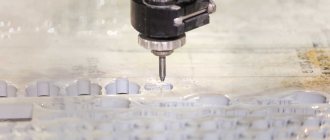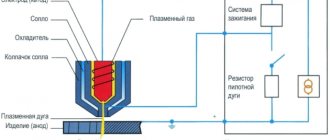In steelmaking shops, the smelting of rolled metal and sheets is carried out using the in-line method, so many materials have large dimensions (length, width, area). Therefore, many metal objects need to be cut - metal shears do a good job of this task. They look like small or medium-sized machines that perform cutting using knives.
What operations does a metal shear press do? What operating features of these machines should an engineer know about? And what models of machine tools are used in Russia? These issues will be discussed below.
Shear presses and combined shear presses
Let's resolve the terminological issue so that the reader does not have any confusion:
- Press shears (PN). These are machines and machine equipment that look like scissors, where metal is cut using pressure energy. PN are intended for cutting, chopping, cutting out metal objects. They are not suitable for pressing or making notches, holes, or marks.
- Combined press shears (CPN). According to the operating principle and design of the KPN, they are similar to conventional press shears. The difference between combined machines is the presence of a press and special attachments that allow not only cutting metal, but also making notches and making holes.
Today, almost all machines are equipped with a press and means for making holes and notches. Therefore, de facto, most press shears for metal are combined-type installations (that is, all main shears are CPN). Standard PN systems without an auxiliary press are quite rare in practice. They fell out of use due to their lower versatility. Although press shears are not of a combined type, they are still found in the production of inexpensive home equipment. Therefore, in our article, by the phrase press shears we will mean CPN installations.
Recommendations for optimal use of the machine
Since combined shears are not high-precision separating equipment, when performing adjustment operations it is necessary to ensure that the depth of penetration of the movable and stationary knives into the cut rolled product does not exceed 25% of the original overall dimension of the metal section indicated in the passport. This condition is extremely important for cutting highly plastic metals and alloys (for example, aluminum). As a last resort, it is permissible to use heated cutting, when the original semi-finished product is heated to 150...200 °C. This condition is most often implemented for the separation of high-carbon (containing more than 0.5% C) or alloy steels.
When planning to use a hole-punching press, it is worth initially setting increased (compared to those recommended in the passport) gaps between the side guides of the puller and the workpiece, otherwise it may bend and bulge in the area of action of the hole-punching punch.
The passport for the machine also indicates the conditions for installing the scissors. Since this equipment is not characterized by the shock nature of its work, a special foundation is not required. The absence of an electro-pneumatic activation system allows the shears to be installed outdoors, supplying the moving parts with lubricant suitable for use in the appropriate temperature conditions. The equipment must be covered with a moisture-proof canopy.
Technical differences of CPN
Combined press shears look like industrial machines of small or medium size. The vast majority of installations are electrically powered, and they are designed to work with metal objects of various types (this can be rolled metal, individual sheets, solid parts).
Modern installations perform the following operations:
- Cutting metal objects of all basic types (steel, cast iron, aluminum, copper + alloys).
- Cutting of profile/shaped metal products (pipes, channels, corner metal products).
- Pressing, making holes, notches, marks of various shapes.
- Cutting grooves, cutting metal structures into individual elements or blanks.
Combination press shears are suitable for many areas of modern industry. The thing is that modern production needs simple but effective equipment that quickly cuts metal into individual parts. Such equipment must work accurately without deforming the final objects. An important point is also the installation price, since not every factory or workshop can afford expensive equipment. All these tasks can be performed by CPN units - they are easy to operate, they are inexpensive, have a long service life, and cut metal accurately.
Main technical purpose and operational parameters
The passport for the machine notes that this technique makes it possible to perform universal separation operations of plastic deformation with workpieces of various assortments - strips, profiled metal products (angle, both equilateral and unequal, circle, square). It is possible to punch holes and make shaped grooves in sheet and shaped rolled products. When installing additional devices and stamping tools (the specifications and nomenclature of which are given in the passport) on the combined scissors in question, it is also possible to perform sectional stamping of contours element by element, contour cutting and strip cutting, and even straightening. The machine passport includes a list of quick-change parts and tools, using which you can easily reconfigure the unit to work with various initial products.
Such a variety of cold stamping transitions allows for the effective use of combined shear presses in small-scale and individual production of products from various rolled steel profiles.
Shears model HB 5222 are easily integrated into specialized production lines for performing cutting and blank transitions for cold stamping of rolled products.
Combined press shears HB5222 after major overhaul
The main technical characteristics of scissors that comply with the standards TU 2-041-284-83 are:
- The maximum thickness of the material to be separated, mm, is 16 (based on the assumption that the strength of the metal or alloy is 450 MPa; for other values of mechanical parameters, the limit value of this parameter is established experimentally).
- The maximum dimensions of the strip to be cut (width×thickness), mm—190×18.
- The largest diameter of round rolled metal, mm (under the same conditions as point 1) – 50.
- Dimensions of an isosceles corner, the shelves of which are located perpendicular to each other, mm - 125 × 125 × 14.
- For the punching press assembly, the largest diameter of the hole to be punched, mm, is 32.
- Number of strokes of the main drive slider (adjustable), min -1 – 17…53.
- Electric motor power. kW – 4.8.
- Overall dimensions of the equipment (length×width×height), mm - 1780×1030×1865.
- Equipment weight, kg – no more than 2500.
Technical characteristics of HB5222
Operating principle of CPN
CPN installations have a more or less standard design, which differs slightly from model to model. The simplest press shears consist of two guillotine knives or disks, which are located on top of each other. The installation is equipped with a press that creates the necessary pressure for cutting metal objects. CPN machines are also equipped with an auxiliary press and attachments that allow making holes and notches in the metal. The operating principle of the press is hydraulic or mechanical. In addition, the cutting unit is equipped with auxiliary parts that perform many auxiliary but important functions - transmitting pressure to the active zone, fixing the workpiece, stop, pressure regulation.
CPN units have become widespread in the field of mass production (they are used by both small factories and large metallurgical plants). They are used in the mechanical engineering sector, at metal depots, on stamping lines, in procurement shops, and in repair shops. Most shearing units can be easily integrated into an automatic production line.
Advantages of press shears for metal:
- Reliability. If you follow the rules for using the installation, the combined press shears for metal will last a long time, and the risk of breakage is minimal. In addition, the use of CPN is safe for workers, which is also a plus.
- Easy to use, no vibration. Industrial scissors are easy to use, so the worker does not need to master complex skills to operate the equipment. In addition, the absence of vibration helps to increase the quality of work + minimizes the risk of traumatic situations.
- The versatility of CPN. Scissors perform many operations. This includes cutting metal objects of all basic types, cutting rolled metal, pressing, cutting grooves, cutting, making holes of various shapes.
- High quality work, cost-effectiveness. Metal processing is carried out with great precision, and the risk of industrial waste formation is minimal. This has a positive effect on savings, which will help reduce related production costs in the workshop.
- Low price. There are both expensive and cheap systems on sale. The owner of the production will be able to select scissors for a workshop, industrial workshop, or complex factory line.
Information about the manufacturer of the shear press HB5222
The manufacturer of the NV5222 press shears is the Kuvandyk plant of forging and pressing equipment "Dolina" , founded in 1941.
Machines produced by the Kuvandyk Forging and Pressing Equipment Plant
- GD-162
- straightening machine for cutting reinforcing steel Ø 16 - HB5221
– combined shear press Ø 45 - HB5222
– combined shear press Ø 50 - NG5222
– combined shear press Ø 45 - NG5223
– combined shear press Ø 50 - NG5224
– combined shear press Ø 67
Types of scissors
Shear presses can differ from each other in a number of parameters - drive type, power, dimensions, list of available operations, number of active zones. The main varieties are the following types of CPN - lever, disk, hydraulic, container, for scrap.
Lever systems
These scissors are small in size, so they are suitable for processing small parts. They are used in small workshops or workshops, as well as in scrap metal collection points. Lever systems are lightweight, so they can be quickly moved from one place to another if necessary. The operating principle of such systems looks like this:
- On the installation, two guillotine knives are fixed above each other. The length of the blades usually does not exceed 10 centimeters. The lower knife is fixed motionless, while the upper knife is driven by muscular force.
- To cut, press or make a hole, a person places the part in the work area. Then he pulls a lever, which creates the required level of pressure, which leads to cutting the part.
- As is clear from the description, lever systems do not have electrical elements. Therefore, with such installations it is possible to cut anywhere without the need to connect the system to a power source.
Disk systems
Such installations are similar in structure and nature of use to lever systems with some important differences:
- Instead of guillotine knives, two sharp disks are used that rotate in the opposite direction relative to each other.
- In most cases, the drives are connected to an electrical power source. The system is controlled using a lever that allows you to bring the disk into the active zone.
Disk systems have many advantages. The advantage is that the worker will not need to waste his energy for work, since cutting is carried out using electric disks connected to a generator. In addition, such cutting is fast and accurate, and deformation and burrs do not form on the part. Disk units are usually small in size, so they are also only suitable for processing small parts in workshops or small workshops.
Hydraulic systems
Hydraulic CPNs usually have medium or large sizes, and they are usually used in medium and large industrial workshops in production. Hydraulics allow you to develop high pressure, which allows you to cut and process even the thickest and most durable metal parts.
The base of hydraulic installations is usually made of concrete, and the frame is made by welding. For cutting, two massive knives are usually used, which are connected to a hydraulic press. The bed is quite large in size, which allows it to dampen vibrations during work, which can significantly improve the quality of cutting. Hydraulic CPN systems can cut metal at an angle. Therefore, they can also be used to make complex frame structures or parts for cars.
CPN for scrap
Such systems are very large in size, and they have a mechanical or mechanical-hydraulic operating principle. Such systems are used for recycling scrap - metal, automobile, steel. Scrap shears are used in large metallurgical plants as part of more complex systems. CPPs for scrap are usually equipped with several autonomous sections, which significantly speeds up and simplifies the operator’s work. Also, many systems are equipped with a compaction chamber, which allows you to package scrap metal.
Container systems
Such systems are similar in design and structure to previous installations, with the only difference being that container installations are more mobile. Whereas systems for working with scrap are usually monolithic systems. If necessary, the container unit can be quickly dismantled and transported to the desired location, which significantly increases the mobility of the CPT. In all other respects, CPTs are similar to previous systems - they consist of several independent departments, the installation is equipped with a special chamber for pressing chopped scrap metal.
Hand shears for metal
Design of manual shears
Manual press shears
The working part of the machine is two blades (knives) about 10 cm long. One of them is fixedly attached to the bed, the second can move in a vertical plane under the action of a lever mechanism. The lever is driven by the operator's muscular force and, through a mechanical transmission system, acts on the knife.
Using manual lever machines, you can cut sheet metal (steel) up to 8 mm thick and non-ferrous alloys up to 10 mm, reinforcement and rods with a diameter of up to 1.8 cm. Lever-type manual scissors are made from tool steel and alloys of grades P18, U8, U9 or their analogues.
Popular CPN models
A large number of varieties of combined industrial type shear presses are produced. In Russia, the following models are most widespread: SMZh625, NV5221, NV5222, NV5224. The most popular model remains the HB5221 installation. Below we will briefly look at the features of these models.
SMF625
It belongs to the category of simple, compact and cheap models, with which you can perform all basic metal work. Areas of application: cutting shaped or long rolled metal, working with metal sheets, punching holes, making triangular notches. The SMZH625 installation can be adapted for use in open areas. An additional application of SMZH625 is working with metal and rolled metal on construction sites with low or medium levels of pollution. The machine is used in temperate climates.
HB5221
This model belongs to the category of large massive machines that are designed to work with large batches of metal. HB5221 is suitable for working with all popular types of rolled metal (shaped, long, strip). This machine can be used for making holes, cutting out various notches and notches. The device has 4 active zones. This allows you to significantly increase labor productivity, which will be very useful in the case of large metallurgical industries (mechanical engineering, production of military equipment, construction of sea vessels, repair work). HB5221 machines have slight design differences due to the climate of primary use. A simple example: the UHL modification of the HB5221 machine is used to work in moderate or cold climates.
HB5222
This model is a modification of the previous HB5221 system. A major difference between this type of installation is that the 4 zones of the HB5222 press system operate in a completely autonomous mode. This allows the operator to efficiently organize work in production. Model HB5222 is designed to work with all types of rolled metal, for cutting sheet metal, for making holes, notches or recesses. This model of scissors is used in construction or engineering industries. Another area of application is small compact workshops, specializing in the dismantling of prefabricated metal structures (machines, equipment).
HB5224
This unit is an improved modification of the HB5221 model. The device is universal - it is suitable for processing sheets, rolled metal, various blanks and solid parts. Like the classic model, the HB5224 system is divided into 4 zones, which perform all basic operations with metal - cutting, making holes, pressing. The basic differences of the HB5224 are improved automation, the use of stronger metal alloys with anti-corrosion additives, the availability of equipment for notching operations, and the ability to cut angle metal.
